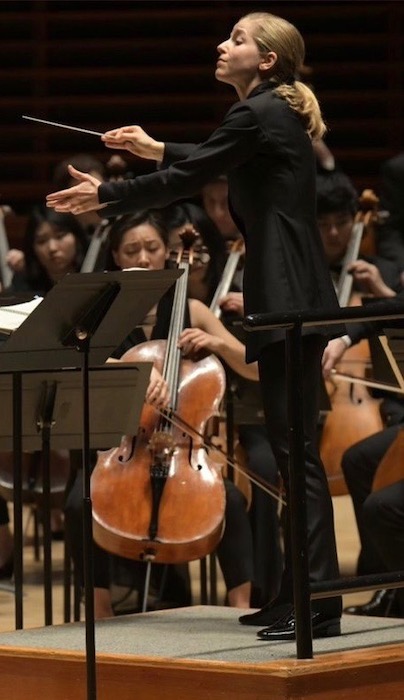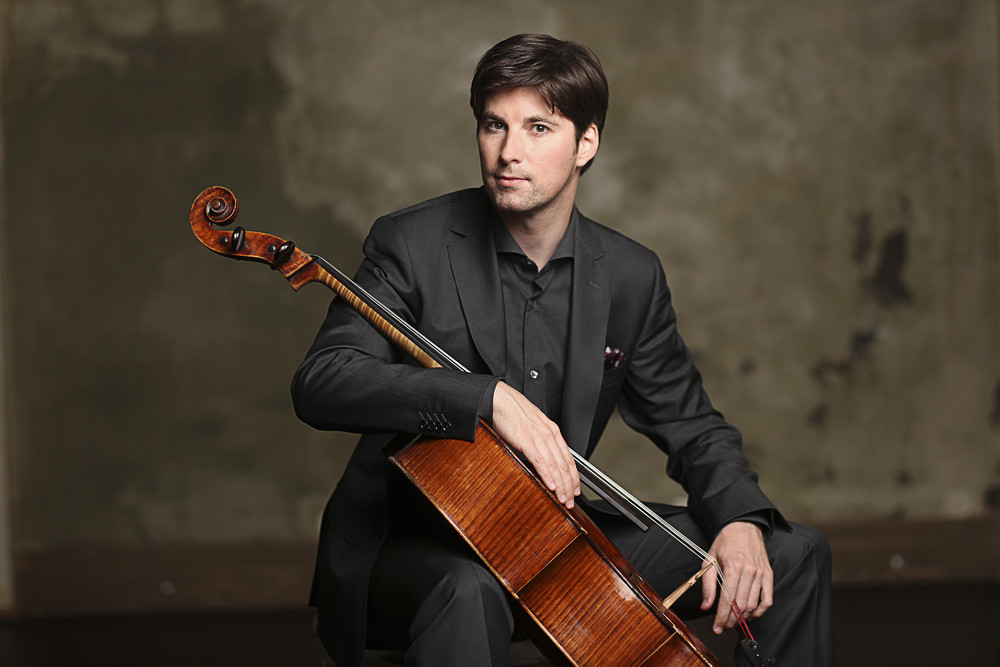Canellakis, Dallas Symphony serve up an evening of Romantic rarities

Karina Cannelakis conducted the Dallas Symphony Orchestra Thursday night.
Familiar composers, not-so-familiar works, and a unique arrangement of repertoire characterized Thursday’s concert of the Dallas Symphony Orchestra under guest conductor Karina Canellakis at Meyerson Symphony Center.
Canellakis, who will become chief conductor of the Radio Philharmonic Orchestra of the Netherlands beginning this fall, is no stranger to Dallas, having served as assistant conductor of the Dallas Symphony from 2014-16. And that familiarity with the hall and the orchestra clearly stood her in good stead Thursday in a concert designed to play to the orchestra’s strengths and the acoustic qualities of the room.
The opening item, Elgar’s Sursum Corda (“Lift Up Your Heart”), features a prominent role for organ with orchestra of strings, brass, and timpani, to create a brief, resonantly magnificent work. Composed specifically for a ceremonial event in Worcester Cathedral in 1894, Sursum Corda transcends the whiff of Victorian religiosity and ceremony with the sense of personal warmth that pervades Elgar’s music at its best. Canellakis delivered that late romantic passion unapologetically and with insight. After a slightly rough brass entry, the orchestra warmed up nicely to the sweep of this brief but majestic score.
Canellakis then turned to the least frequently performed of Beethoven’s nine symphonies, No. 4 in B-flat. (Canellakis is, indeed, the only conductor to have performed the work with the orchestra in recent years, having conducted it in 2016.) Here, Beethoven pours his middle period muscularity (most famously familiar in Symphony No. 5) into a Haydnesque structure; Canellakis and the orchestra (with string section reduced to classical-era proportions) produced an entrancing suspense in the sustained introduction before launching the energy of the main theme.
Canellakis convincingly preserved the throbbing accompaniment figure of the Adagio movement, in constant tension with the soaring tune floating above; unbounded vigor returned in the Menuetto, with Canellakis underlining the rapid, sometimes surprising constrasts of the movement. She likewise guided the orchestra precisely and powerfully through the technical hazards of the Finale, with one foot in the classical era and one in the romantic.

Daniel Müller-Schott
The reduced orchestra returned for Schumann’s Cello Concerto with an impressive performance by soloist Daniel Müller-Schott, who most recently appeared with the Dallas Symphony in Dvořák’s Cello Concerto in 2015. Three haunting opening chords from the orchestra were answered by an equally intense entry by Müller-Schott; unfailingly detailed phrasing and a darkly attractive tone quality characterized the performance with Müller-Schott projecting handsomely above the orchestra throughout.
Along with a beautiful lyrical line, Müller-Schott also demonstrated flawless technique—in bursts in the first movement, and in stamina-challenging stretches in the finale; Müller-Schott’s duet with principal cellist Christopher Adkins in the slow movement was pure magic. We tend to think of Dvořák’s as the first great cello concerto, but this imaginatively conceived, tightly structured work in three continuous movements, composed half a century before the Dvořák, deserves more attention and recognition.
Canellakis intriguingly returned to Elgar for the final item on the program; the personal warmth of the composer, broadly hinted in Sursum Corda, blossoms into full power in the overture In the South (Alassio), inspired by a visit by Elgar and his family to the Italian Riviera in 1903.
Canellakis not only made a strong case for herself as an Elgar interpreter but also for this shimmering, vividly orchestrated tone poem as a work worthy of inclusion among the great tone poems of the romantic era. Here, Elgar releases full-blown Edwardian sensuousness, enlivened by a well-developed management of chromatic harmony and late romantic orchestration. It’s definitely akin to Wagner and Richard Strauss, but the unique stamp of Elgar’s personality is clearly present.
Canellakis masterfully handled the titanic rising theme in the middle section. Acting principal violist Ann Marie Brink performed the extended viola obbligato with warm expressiveness.
The program will be repeated at 7:30 p.m. Friday and Saturday and at 2:30 p.m. Sunday at Meyerson Symphony Center. mydso.com; 214-692-0203.